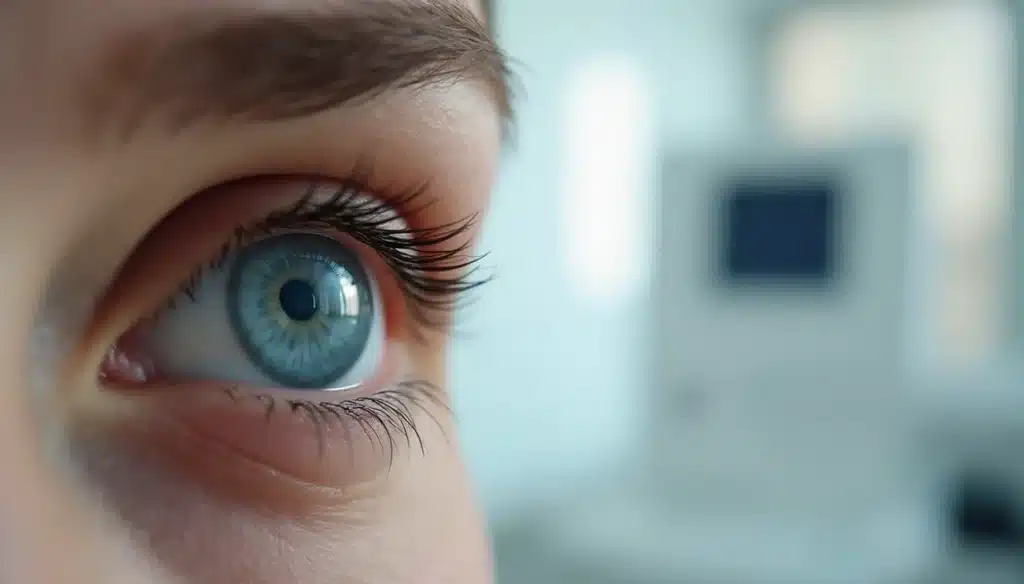Did you know that 80-90% of your LASIK recovery happens within just the first 24 hours? Most patients can drive just one day after their procedure. The original healing moves quickly, but your complete LASIK eye surgery recovery extends beyond this first phase. Your eye needs 2-3 months to heal after LASIK surgery, and full vision stability usually comes at the 6-month mark.
Your recovery from laser eye surgery follows a predictable healing pattern. More than 90% of patients achieve 20/20 uncorrected visual acuity. Each patient’s healing trip varies based on their procedure and natural healing time.
We at Precision Vision London know that understanding laser eye surgery recovery helps reduce your concerns. Proper aftercare plays a vital role, and following clinical guidance will give a better outcome. This complete week-by-week LASIK recovery timeline will guide you through your healing process. Would you like to learn what happens after your LASIK procedure? Let’s explore your recovery details together.

Week 1: The First 7 Days After LASIK
The first week after LASIK is vital to proper healing and best results. This time shapes your recovery and needs specific care to get the best outcome.
What to expect in the first 24 hours
The numbing drops wear off in 30-90 minutes. You might feel a gritty sensation in your eyes, like sand. Your vision will be somewhat blurry—many patients say it’s like looking through a dirty window. The discomfort peaks early but gets better by the end of the day. Your vision improves almost right away. About 80-90% of healing happens on day one. You might see halos around lights and feel sensitive to brightness during this time.
Common symptoms and how to manage them
During the first week, you might notice:
- Burning or itching sensations
- Watery eyes and mild discomfort
- Red or bloodshot eyes
- Light sensitivity
- Changes in vision
Your prescribed lubricating eye drops help manage these symptoms—use them often, especially when your eyes feel dry. Sunglasses help with light sensitivity both inside and outside. On top of that, it helps to take over-the-counter pain relievers with your surgeon’s approval.
Using eye drops and protective shields
Your surgeon will give you different eye drops: antibiotics to fight infection, steroids to reduce swelling, and artificial tears to keep eyes moist. Use them on schedule, even if your eyes feel fine. You must wear protective eye shields while sleeping for at least a week. These shields keep you from rubbing your eyes or bumping the healing corneal flap.
When to rest and when to resume light activity
Good rest in the first 48 hours speeds up recovery. Stay away from screens for 24 hours. You can go back to work within 48 hours, but wait three days before using computers. Light tasks like housework or shopping can start the day after surgery. Wait a week before swimming or heavy exercise. You can drive once your surgeon checks your vision—usually from day two.
Week 2: Adjusting to Vision Changes
Your vision continues to stabilise by a lot during the second week after LASIK. Your eyes adapt to their new visual reality and complete important healing processes during this time.
Dealing with light sensitivity and halos
Most patients experience some light sensitivity in week two, though it’s not as intense as the first week. The original corneal swelling causes this sensitivity and usually settles within 24 hours. All the same, you might notice small halos around lights, especially at night. These can last through the first month. High-quality sunglasses will give you maximum comfort outdoors. Your surgeon needs to know right away if you experience sudden or severe light sensitivity several weeks after surgery. This could signal a complication that needs attention.
Tips for screen use and reading
Screen time and reading can resume after the first 24-48 hours of restrictions. Here’s how to protect your healing eyes:
- Follow the 20-20-20 rule: every 20 minutes, look at something 20 feet away for 20 seconds
- Use good lighting to reduce eye strain
- Keep screens 20-26 inches away from your eyes
- Begin with brief reading sessions and build up slowly
- Use preservative-free artificial tears often to curb dryness
Your eyes show good adaptation when you can focus easily for 25-minute stretches without feeling dry. These improvements usually develop throughout the first 1-2 weeks after surgery.
Avoiding makeup, dust, and water exposure
Your eyes need protection from irritants during week two:
- Avoid eye makeup (mascara, eyeliner, eyeshadow) for the full week
- Stay away from dusty places and gardening for at least a week
- Don’t let tap water touch your eyes for a week after surgery
- Stay out of swimming pools, saunas and hot tubs for at least four weeks
Weeks 3–4: Returning to Normal Activities
Most patients see steady vision improvements and fewer symptoms during weeks 3-4 of their LASIK recovery. Their eyes adapt better, which makes daily tasks much easier.
Getting back to exercise and driving
You can start returning to more demanding activities during this period. Light exercise usually starts after just one week, and moderate outdoor activities become safe after two days. You should wait about three weeks before doing intense workouts. Contact sports need at least four weeks of recovery time. Players should stay away from boxing, martial arts, and rugby until six weeks have passed. Most patients get their driving clearance at their first follow-up visit. Daytime driving becomes safe after 24-48 hours, but night driving needs extra care because lights might cause glare.
Swimming and travel rules
Different swimming locations have different waiting periods:
- Swimming pools: Safe after 2-4 weeks if you wear goggles
- Natural bodies of water: A three-week minimum wait is needed
- Swimming without goggles: Becomes safe after 4-5 weeks
Patients can take domestic trips three days after surgery, but international travel needs two weeks of recovery time. Air travellers should use preservative-free eye drops often to fight cabin dryness.
Keeping track of vision changes
Vision changes happen often during weeks 3-4. Your prescription stabilises naturally as part of the healing process. Precision Vision London’s expert surgeons track these changes carefully during follow-up visits to ensure the best recovery possible.
Months 2–6: Long-Term Healing and Stability
Your eyes continue to heal and stabilise during months 2-6 after LASIK surgery. This final phase completes your laser eye surgery recovery.
Follow-up appointments and vision checks
Vision checks at three and six months play a significant role in your recovery. Your surgeon will track your progress, answer your questions, and make sure you get the best results. These checkups help monitor your corneal healing, vision clarity, and any lingering side effects.
Understanding enhancement procedures
About 3-5% of patients need a LASIK enhancement to perfect their results. You can opt for this touch-up after your vision stays the same for two checkups that are at least three months apart. The enhancement works like your original procedure but takes only minutes. Precision Vision London provides these enhancements to help achieve the best possible results.
When to expect full visual clarity
Most patients see clearly and consistently within 2-3 months. Full stability usually happens around six months. Patients with stronger prescriptions might need more time. Side effects like halos or glare should fade gradually during this time.
How Precision Vision London supports your recovery
Each patient’s LASIK experience is different. A well-defined recovery timeline helps reduce anxiety. Precision Vision London’s expert team supports you from surgery through complete healing. Book your LASIK consultation today to start your trip toward clearer, worry-free vision.
Conclusion
Knowing your LASIK recovery timeline helps reduce anxiety about the procedure. You’ll be glad to know that 80-90% of healing happens in just 24 hours, though your vision continues to stabilise over 2-3 months. Proper aftercare is vital to get the best results from your laser eye surgery. Your recovery experience follows a clear pattern. The first week focuses on basic healing and specific restrictions. By weeks 3-4, you can return to your normal activities. Your vision keeps stabilising through months 2-6. Regular check-ups help track your progress and tackle any issues that come up.
Most patients get excellent vision without extra treatment. About 3-5% of patients might need a touch-up procedure to fine-tune their results. These adjustments become possible once your vision stays stable between appointments. Each person’s LASIK experience is different, but having a clear timeline helps put your mind at ease. Precision Vision London’s team supports you from your surgery day until you’re fully healed. Book your LASIK consultation today to start your path to clearer vision without stress.
Key Takeaways
Understanding your LASIK recovery timeline helps reduce anxiety and ensures optimal healing outcomes through proper aftercare and realistic expectations.
- 80-90% of LASIK healing occurs within the first 24 hours, though complete vision stability takes 2-3 months to achieve.
- Week 1 requires strict eye protection with shields, prescribed drops, and avoiding screens for 24-48 hours whilst managing light sensitivity.
- Weeks 2-4 allow gradual return to normal activities including driving, light exercise, and screen use with proper precautions.
- Full visual clarity typically stabilises by 6 months, with only 3-5% of patients requiring enhancement procedures for optimal results.
- Regular follow-up appointments at 3 and 6 months are crucial for monitoring healing progress and addressing any concerns promptly.
The key to successful LASIK recovery lies in following your surgeon’s aftercare instructions precisely and maintaining realistic expectations about the healing timeline. Most patients achieve excellent vision outcomes when they adhere to the recommended recovery protocols.
FAQs
Q1. How long does it take to fully recover from LASIK surgery? While 80-90% of healing occurs within the first 24 hours, complete visual stability typically takes 2-3 months to achieve. Most patients experience full vision clarity around the 6-month mark.
Q2. When can I resume normal activities after LASIK? You can usually return to work within 48 hours and resume light activities like housework the day after surgery. However, it’s best to wait about a week before engaging in strenuous exercise and at least four weeks before swimming.
Q3. Are there any restrictions on screen use after LASIK? It’s recommended to avoid screens for the first 24-48 hours. After that, you can gradually reintroduce screen time, following the 20-20-20 rule: every 20 minutes, look at something 20 feet away for 20 seconds.
Q4. How often should I use eye drops during LASIK recovery? You should use prescribed eye drops (antibiotics, steroids, and artificial tears) strictly according to schedule, even if your eyes don’t feel dry. This is crucial for proper healing and preventing complications.
Q5. Will I need a follow-up procedure after LASIK? Most patients achieve excellent vision without further intervention. However, approximately 3-5% of patients may require an enhancement procedure to fine-tune their results, which can be done once vision remains stable for at least three months.
Authors & Reviewer
-
 Olivia: Author
Olivia: AuthorHi, I'm Olivia, a passionate writer specialising in eye care, vision health, and the latest advancements in optometry. I strive to craft informative and engaging articles that help readers make informed decisions about their eye health. With a keen eye for detail and a commitment to delivering accurate, research-backed content, I aim to educate and inspire through every piece I write.
-
 Dr. CT Pillai: Reviewer
Dr. CT Pillai: ReviewerDr. CT Pillai is a globally recognised ophthalmologist with over 30 years of experience, specialising in refractive surgery and general ophthalmology. Renowned for performing over 50,000 successful laser procedures.

